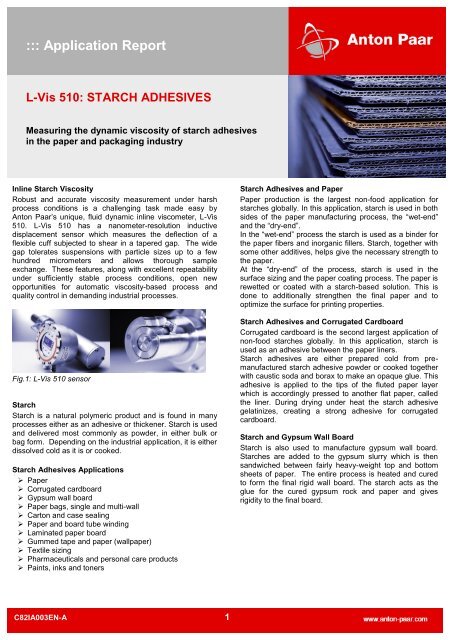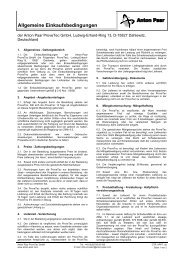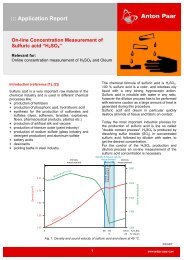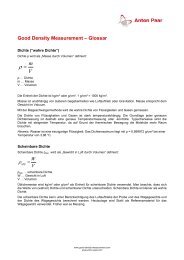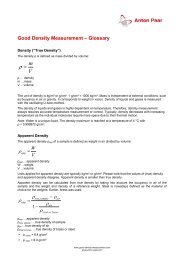L-Vis 510: STARCH ADHESIVES - Anton Paar.com
L-Vis 510: STARCH ADHESIVES - Anton Paar.com
L-Vis 510: STARCH ADHESIVES - Anton Paar.com
You also want an ePaper? Increase the reach of your titles
YUMPU automatically turns print PDFs into web optimized ePapers that Google loves.
::: Application Report<br />
L-<strong>Vis</strong> <strong>510</strong>: <strong>STARCH</strong> <strong>ADHESIVES</strong><br />
Measuring the dynamic viscosity of starch adhesives<br />
in the paper and packaging industry<br />
Inline Starch <strong>Vis</strong>cosity<br />
Robust and accurate viscosity measurement under harsh<br />
process conditions is a challenging task made easy by<br />
<strong>Anton</strong> <strong>Paar</strong>’s unique, fluid dynamic inline vis<strong>com</strong>eter, L-<strong>Vis</strong><br />
<strong>510</strong>. L-<strong>Vis</strong> <strong>510</strong> has a nanometer-resolution inductive<br />
displacement sensor which measures the deflection of a<br />
flexible cuff subjected to shear in a tapered gap. The wide<br />
gap tolerates suspensions with particle sizes up to a few<br />
hundred micrometers and allows thorough sample<br />
exchange. These features, along with excellent repeatability<br />
under sufficiently stable process conditions, open new<br />
opportunities for automatic viscosity-based process and<br />
quality control in demanding industrial processes.<br />
Fig.1: L-<strong>Vis</strong> <strong>510</strong> sensor<br />
Starch<br />
Starch is a natural polymeric product and is found in many<br />
processes either as an adhesive or thickener. Starch is used<br />
and delivered most <strong>com</strong>monly as powder, in either bulk or<br />
bag form. Depending on the industrial application, it is either<br />
dissolved cold as it is or cooked.<br />
Starch Adhesives Applications<br />
�<br />
� Paper<br />
� Corrugated cardboard<br />
� Gypsum wall board<br />
� Paper bags, single and multi-wall<br />
� Carton and case sealing<br />
� Paper and board tube winding<br />
� Laminated paper board<br />
� Gummed tape and paper (wallpaper)<br />
� Textile sizing<br />
� Pharmaceuticals and personal care products<br />
� Paints, inks and toners<br />
C82IA003EN-A<br />
1<br />
Starch Adhesives and Paper<br />
Paper production is the largest non-food application for<br />
starches globally. In this application, starch is used in both<br />
sides of the paper manufacturing process, the “wet-end”<br />
and the “dry-end”.<br />
In the “wet-end” process the starch is used as a binder for<br />
the paper fibers and inorganic fillers. Starch, together with<br />
some other additives, helps give the necessary strength to<br />
the paper.<br />
At the “dry-end” of the process, starch is used in the<br />
surface sizing and the paper coating process. The paper is<br />
rewetted or coated with a starch-based solution. This is<br />
done to additionally strengthen the final paper and to<br />
optimize the surface for printing properties.<br />
Starch Adhesives and Corrugated Cardboard<br />
Corrugated cardboard is the second largest application of<br />
non-food starches globally. In this application, starch is<br />
used as an adhesive between the paper liners.<br />
Starch adhesives are either prepared cold from premanufactured<br />
starch adhesive powder or cooked together<br />
with caustic soda and borax to make an opaque glue. This<br />
adhesive is applied to the tips of the fluted paper layer<br />
which is accordingly pressed to another flat paper, called<br />
the liner. During drying under heat the starch adhesive<br />
gelatinizes, creating a strong adhesive for corrugated<br />
cardboard.<br />
Starch and Gypsum Wall Board<br />
Starch is also used to manufacture gypsum wall board.<br />
Starches are added to the gypsum slurry which is then<br />
sandwiched between fairly heavy-weight top and bottom<br />
sheets of paper. The entire process is heated and cured<br />
to form the final rigid wall board. The starch acts as the<br />
glue for the cured gypsum rock and paper and gives<br />
rigidity to the final board.
::: Application Report<br />
L-<strong>Vis</strong> <strong>510</strong>: <strong>STARCH</strong> <strong>ADHESIVES</strong><br />
Measuring the dynamic viscosity of starch adhesives<br />
in the paper and packaging industry<br />
Current Facilities Using L-<strong>Vis</strong> <strong>510</strong><br />
The facilities in which L-<strong>Vis</strong> <strong>510</strong> is currently used include,<br />
but are not limited to, paper box and corrugated cardboard<br />
box and other corrugated cardboard manufacturers.<br />
L-<strong>Vis</strong> <strong>510</strong> is currently installed in adhesive applications for<br />
the corrugated cardboard industry in both the adhesive<br />
batch tank and the ring loop.<br />
Fig. 2: L-<strong>Vis</strong> <strong>510</strong> in a typical bypass installation in a<br />
circulation loop<br />
Corrugated Cardboard Production<br />
In the production of corrugated cardboard, the starch<br />
adhesive is produced batchwise. Its quality is controlled<br />
via the final viscosity. L-<strong>Vis</strong> <strong>510</strong> is installed in the batch<br />
tank wall (or optionally in a bypass).<br />
Fig. 3: Starch adhesive in a corrugated cardboard facility<br />
C82IA003EN-A<br />
2<br />
In the production of corrugated cardboard, single-point<br />
and/or multi-point circulation loops continuously transport the<br />
starch adhesive to and from the cardboard machines. L-<strong>Vis</strong><br />
<strong>510</strong> is installed in the pipe (or optionally in a bypass) right<br />
before the cardboard machine.<br />
Fig. 4: Single-layer cardboard process<br />
Benefits<br />
The benefits of continuous inline measurement of viscosity<br />
during production are:<br />
� Real-time, continuous quality control and assurance<br />
� Repeatable adhesive batch quality<br />
� Prevention of loss of product<br />
� Reduction of production downtime<br />
� Increased production and profitability<br />
� Automation of the adhesive blending process<br />
Application Data<br />
<strong>Anton</strong> <strong>Paar</strong> has collected numerous data to determine the<br />
flow curve, the viscosity stability related to time and<br />
temperature, overall repeatability and how viscosity reacts<br />
to blending of different starch concentrations. Please see<br />
the following graphs for more detail.
::: Application Report<br />
L-<strong>Vis</strong> <strong>510</strong>: <strong>STARCH</strong> <strong>ADHESIVES</strong><br />
Measuring the dynamic viscosity of starch adhesives<br />
in the paper and packaging industry<br />
Laboratory Measurement<br />
Fig. 5: Flow curve of a typical starch adhesive measured in<br />
the laboratory<br />
Figure 5 demonstrates how the starch viscosity reacts to<br />
shear. At rest, the viscosity of the starch adhesive is over<br />
2000 mPa.s and remains shear-thinning across the entire<br />
range.<br />
These values may vary depending on the individual<br />
application.<br />
Inline <strong>Vis</strong>cosity Measurement - Repeatability<br />
Fig. 6: Repeatability of viscosity values measured by<br />
L-<strong>Vis</strong> <strong>510</strong><br />
C82IA003EN-A<br />
3<br />
The repeatability of the L-<strong>Vis</strong> <strong>510</strong> inline vis<strong>com</strong>eter is also<br />
very stable and represents a difference of only 0.5 % of the<br />
measured value.<br />
Inline <strong>Vis</strong>cosity Measurement - Dilution Reaction<br />
In order to verify the accuracy of the inline viscosity<br />
measurement with L-<strong>Vis</strong> <strong>510</strong> across a wide adhesive range<br />
a thorough dilution test of the starch adhesive was<br />
performed. Starting with a concentration of 16 % and<br />
repeatedly adding the same amount of water obtaining<br />
different concentrations of 15.6 %, 15.2 %, 14.8 % and<br />
14.4 %. The batch quickly homogenizes and any change in<br />
viscosity is quickly seen.<br />
Fig. 7: <strong>Vis</strong>cosity reaction to dilution measured by L-<strong>Vis</strong> <strong>510</strong>
::: Application Report<br />
L-<strong>Vis</strong> <strong>510</strong>: <strong>STARCH</strong> <strong>ADHESIVES</strong><br />
Measuring the dynamic viscosity of starch adhesives<br />
in the paper and packaging industry<br />
Inline <strong>Vis</strong>cosity Measurement – Ongoing Starch<br />
Adhesive Batch Blending<br />
Starch is added to warm water, heated to 40 °C and caustic<br />
soda is added. <strong>Vis</strong>cosity slowly increases to a target<br />
viscosity and a second starch and water addition is made.<br />
Once the final target viscosity is reached, borax is added to<br />
stop the starch conversion and retain the target viscosity.<br />
Fig. 8: Batch production of cooked starch measured by<br />
L-<strong>Vis</strong> <strong>510</strong><br />
Resources:<br />
“Stärkeeinsatz im Papier und deren Dosiereinrichtungen“;<br />
Roquette GmbH, Dr. Mano Wolf<br />
“Verbesserung der Papierfestigkeiten und der<br />
Prozesssicherheit bei der Oberflächenbehandlung von<br />
Wellpappenrohpapieren durch spezifischen<br />
Stärkeaufschluss“; Papiertechnische Stiftung PTS, Birgit<br />
Kießler<br />
C82IA003EN-A<br />
4<br />
Technical Specifications<br />
<strong>Vis</strong>cosity<br />
Measuring range: 1 to 50,000 mPa.s.<br />
Typical accuracy: 1 %<br />
Typical repeatability: 0.5 %<br />
Conditions<br />
Sample temp. range: -5 °C to +200 °C<br />
Ambient temp. range: -20 °C to +40 °C<br />
Sample pressure range: 0 to 10 bar<br />
Material<br />
Housing: stainless steel No. 1.4462,<br />
anodized aluminum<br />
Dimensions (LxWxH): 420 mm x 200 mm x 180 mm<br />
Weight approx. 12 kg<br />
Sensor<br />
Wetted parts: stainless steel No. 1.4462,<br />
diamond-coated SiC seal,<br />
Viton O-ring seal<br />
Installation dimensions (LxØ): min. 130 mm x 100 mm<br />
Connection<br />
<strong>Anton</strong> <strong>Paar</strong> flange set incl. quick coupling<br />
DIN flange > 80 mm; ANSI flange > 3 in<br />
VARIVENT flange > 80 mm or 3 in<br />
Operating terminal<br />
Display: 35 mm x 60 mm<br />
with optical pushbuttons<br />
Analog / digital <strong>com</strong>munication<br />
Analog output: 2 x 4 to 20 mA<br />
Digital output: 1 x<br />
Digital input: 1 x<br />
Fieldbus <strong>com</strong>munication<br />
Profibus DP<br />
ProfiNet<br />
Modbus TCP<br />
Power supply DC 24 V 3.75 A<br />
Degree of protection IP 65


